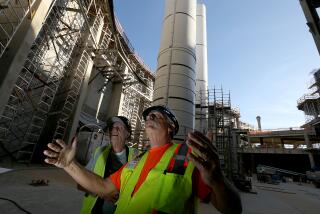Discovery crew installs truss on space station
- Share via
Discovery astronauts completed the first major task of their mission Tuesday, successfully installing the 2-ton P5 truss on the International Space Station’s main backbone during a six-hour spacewalk.
While veteran Robert Curbeam and rookie spacewalker Christer Fuglesang of Sweden directed the maneuver with hand signals, mission specialists Sunita Williams and Joan Higginbotham used the station’s robotic arm to delicately maneuver the $11-million truss into position.
The truss passed within 2 inches of one of the station’s solar arrays, much closer than NASA would prefer, but the installation was completed without incident.
The 11-foot truss brings the length of the backbone to 180 feet. When the station is complete, it will reach 250 feet.
After bolting the truss into place, Curbeam and Fuglesang connected power, data and heater cables to it. They also moved a handle used to grip the truss and replaced a television camera outside the station.
Earlier in the day, NASA engineers in Houston told the Discovery crew that they would not have to perform an extended inspection of the shuttle today.
Sensors on the heat tiles on the belly and wing of the craft had detected “very low” impact readings in several areas, but inspection of photographs of the areas showed no significant abnormalities.
The area will be reinspected next week, after Discovery undocks from the space station.
Engineers were also looking at photos of an orange, cellophane-like material that was sticking out of one of Discovery’s fuel tank doors.
The plastic normally burns off during launch. Engineers want to make sure it is not blocking the door’s seal.
The engineers’ decision will allow the astronauts to proceed with their planned activities today, the most important of which is the retraction of the port solar array on the P6 truss to provide room for installation of four new solar panels, two of which are already on site and two of which are scheduled for delivery next year.
The 6-year-old solar array must be retracted at least 40% to allow the new panels to track the sun properly.
If the array does not automatically retract properly, the crew may have to make an additional spacewalk to free it.
The two remaining scheduled spacewalks, during which the astronauts will rewire the space station’s electrical system, are to take place Thursday and Saturday.
More to Read
Sign up for Essential California
The most important California stories and recommendations in your inbox every morning.
You may occasionally receive promotional content from the Los Angeles Times.













